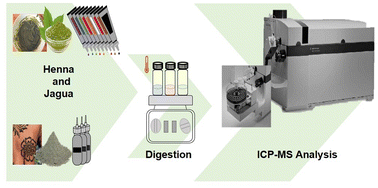The chemistry behind the body art: unveiling the elemental profile and heavy metal content of natural tattoos and dyes by ICP-MS†
Abstract
Temporary tattoos and dyes are increasing popularity as an alternative to permanent ones. However, knowledge on its elementary composition is scarce and, this scientific gap can potentially make them a source of heavy metal exposure on humans. The present research aimed to explore the possibility of using the inorganic chemical signature to characterize natural pigments-based products and to evaluate the heavy metal content in jagua temporary tattoos and henna temporary hair dyes and tattoos. Thirty-four different samples of commercial products were analyzed for the presence and quantity of eleven trace elements (Al, Cr, Mn, Co, Ni, Cu, Zn, As, Cd, Ba, and Pb) by inductively coupled plasma mass spectrometry (ICP-MS). The overall mean concentrations varied between 0.02 and 973 μg g−1 in solid samples or 0.01–1878 μg g−1 for paste ones, wherein potential fake products were uncovered. None of the 34 samples considered comply with the current European Cosmetics Regulation. Samples were differentiated according to their Cr, Zn, Ba, and Pb content. The overall results revealed highly variable levels in the investigated samples, which leads us to suggest detailed quality controls of these materials, due the fact that their continued use can origin potential threat to human health.



 Please wait while we load your content...
Please wait while we load your content...